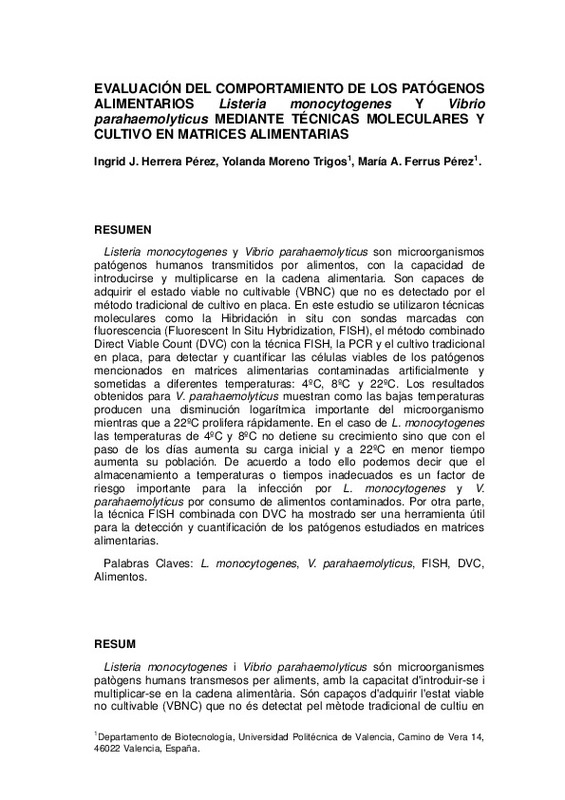|
Resumen:
|
[ES] Listeria monocytogenes y Vibrio parahaemolyticus son microorganismos patógenos humanos transmitidos por alimentos, con la capacidad de introducirse y multiplicarse en la cadena alimentaria. Son capaces de adquirir el ...[+]
[ES] Listeria monocytogenes y Vibrio parahaemolyticus son microorganismos patógenos humanos transmitidos por alimentos, con la capacidad de introducirse y multiplicarse en la cadena alimentaria. Son capaces de adquirir el estado viable no cultivable (VBNC) que no es detectado por el método tradicional de cultivo en placa. En este estudio se utilizaron técnicas moleculares como la Hibridación in situ con sondas marcadas con fluorescencia (Fluorescent In Situ Hybridization, FISH), el método combinado Direct Viable Count (DVC) con la técnica FISH, la PCR y el cultivo tradicional en placa, para detectar y cuantificar las células viables de los patógenos mencionados en matrices alimentarias contaminadas artificialmente y sometidas a diferentes temperaturas: 4ºC, 8ºC y 22ºC. Los resultados obtenidos para V. parahaemolyticus muestran como las bajas temperaturas producen una disminución logarítmica importante del microorganismo mientras que a 22ºC prolifera rápidamente. En el caso de L. monocytogenes las temperaturas de 4ºC y 8ºC no detiene su crecimiento sino que con el paso de los días aumenta su carga inicial y a 22ºC en menor tiempo aumenta su población. De acuerdo a todo ello podemos decir que el almacenamiento a temperaturas o tiempos inadecuados es un factor de riesgo importante para la infección por L. monocytogenes y V. parahaemolyticus por consumo de alimentos contaminados. Por otra parte, la técnica FISH combinada con DVC ha mostrado ser una herramienta útil para la detección y cuantificación de los patógenos estudiados en matrices alimentarias.
[-]
[CA] Listeria monocytogenes i Vibrio parahaemolyticus són microorganismes patògens humans transmesos per aliments, amb la capacitat d'introduir-se i multiplicar-se en la cadena alimentària. Són capaços d'adquirir l'estat ...[+]
[CA] Listeria monocytogenes i Vibrio parahaemolyticus són microorganismes patògens humans transmesos per aliments, amb la capacitat d'introduir-se i multiplicar-se en la cadena alimentària. Són capaços d'adquirir l'estat viable no cultivable (VBNC) que no és detectat pel mètode tradicional de cultiu enplaca. En este estudi es van utilitzar tècniques moleculars com la Hibridació in situ (Fluorescent In Situ Hybridization, FISH) , el mètode combinat Direct Viable Count (DVC) amb la tècnica FISH, la PCR i el cultiu tradicional en placa, per a detectar i quantificar les cèl·lules viables dels patògens mencionats en matrius alimentàries contaminades artificialment i sotmeses a diferents temperatures: 4ºC, 8ºC i 22ºC. Els resultats obtinguts per a V. parahaemolyticus mostren com les baixes temperatures produïxen una disminució logarítmica important del microrganismo mentres que a 22ºC prolifera ràpidament. En el cas de L. monocytogenes les temperatures de 4ºC i 8ºC no deté el seu creixement sinó que amb el pas dels dies augmenta la seua càrrega inicial i a 22ºC en menor temps augmenta la seua població. D'acord amb tot això podem dir que l'emmagatzemament a temperatures o temps inadequats és un factor de risc important per a la infecció per L. monocytogenes i V. parahaemoyiticus per consum d'aliments contaminats. D'altra banda, la tècnica FISH combinada amb DVC ha mostrat ser una ferramenta útil per a la detecció i quantificació dels patògens estudiats en matrius alimentàries.
[-]
[EN] Listeria monocytogenes and Vibrio parahaemolyticus are human pathogenic microorganisms transmitted by food, with the ability to enter and spread in the food chain. They are able to enter a state in which they remain ...[+]
[EN] Listeria monocytogenes and Vibrio parahaemolyticus are human pathogenic microorganisms transmitted by food, with the ability to enter and spread in the food chain. They are able to enter a state in which they remain viable but cannot be detected by the traditional plating culture method (VBNC). In this study we used molecular techniques such as in situ hybridization (Fluorescent In Situ Hybridization, FISH), the combined Direct Viable Count (DVC) and FISH method, the PCR and the traditional culture plating to detect and quantify the viable cells of the mentioned pathogens in food matrices artificially contaminated and subjected to different temperatures: 4 ° C, 8 º C and 22 ° C. The results obtained for V. parahaemolyticus show a large logarithmic reduction of microorganism at the lower temperature of 4 ° C, while at 22 ° C there is a rapid growth. In the case of L. monocytogenes, the lower temperatures of 4 ° C and 8 º C not only does not stop the growth, but shows an increase of the population with time. At 22 º C the spread of the pathogen is even more accelerated. According to our results, we can say that there is a high risk of infection with L. monocytogenes and V. parahaemoliticus by consuming food stored at inappropriate temperatures or times. On the other hand, we have identified the combined FISH-DVC technique as the most effective for the detection and quantification of pathogens in the food matrices studied.
[-]
|







